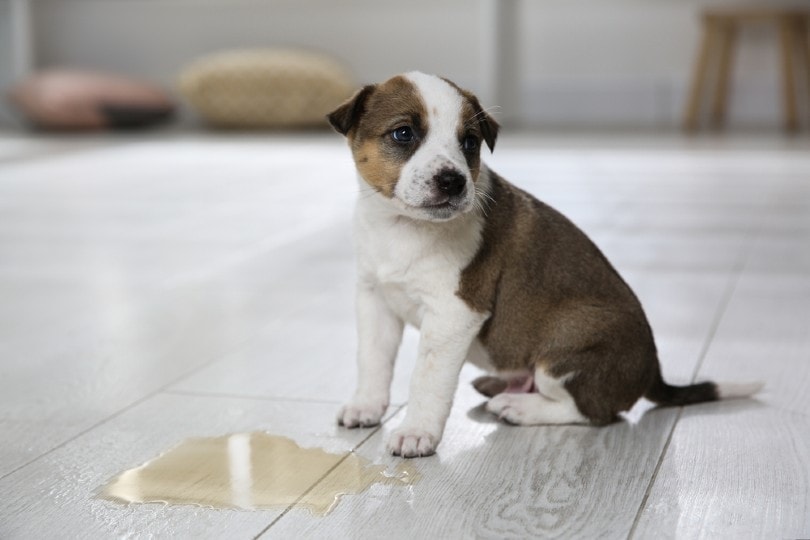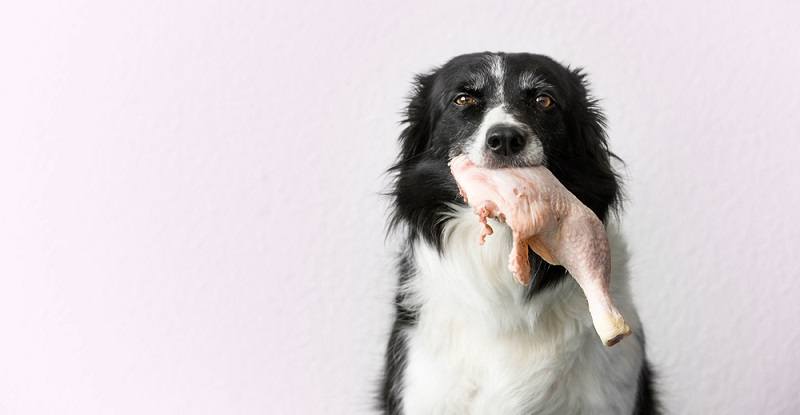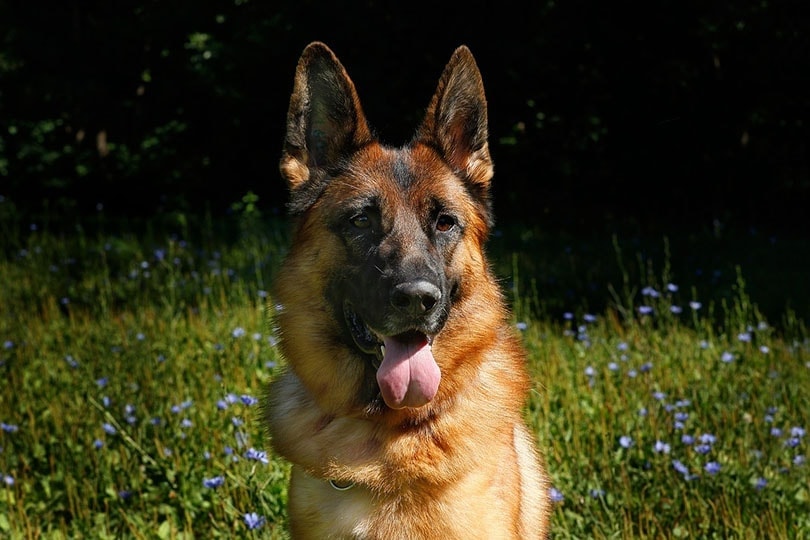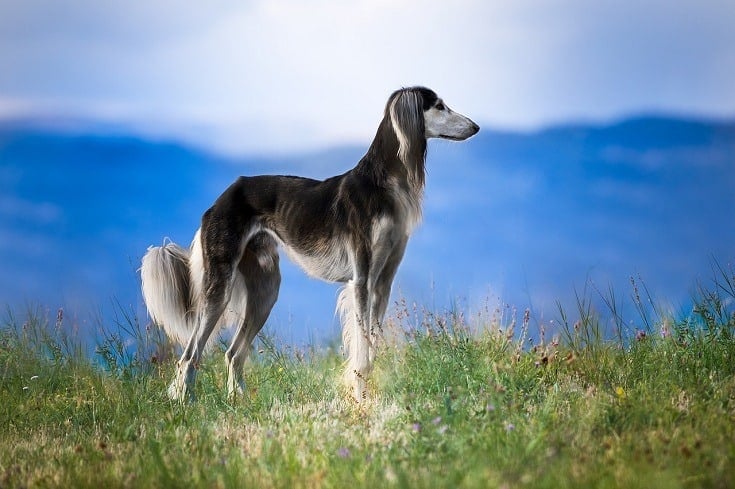Height:
20 – 23.5 inches
Weight:
35 – 60 pounds
Lifespan:
12 – 14 years
Colors:
Black and white, copper-red and white, pure white, grey and white, and agouti
Suitable for:
A highly active individual or family that loves spending time exercising and exploring the outdoors.
Temperament:
Loving, mischievous, outgoing, free-spirited, and highly energetic
The Siberian Husky is an immensely popular medium-sized dog with an ancient lineage that dates back 4,000 years or more. While everyone knows that they come from Siberia, what is not commonly known is that the breed we know today was developed over hundreds of generations by the indigenous Chukchi people (who lived in the Arctic coastal region of Northern Siberia) as a nimble sled dog capable of pulling light loads over exceedingly long distances in some of the world’s harshest conditions.
The breed was imported into Alaska by traders sometime in the late 1800s and first caught the eye of the public in the early 1920s, when they started winning major Alaskan sled races. However, it was the efforts of Leonhard Seppala — who, in 1925, led a relay of Siberian Husky teams 658 miles in just five and a half days to deliver lifesaving diphtheria serum to Nome — that brought great acclaim to the breed.
Today, there are far fewer Siberian Huskies working as sled dogs than those that live their lives as family pets and companions. Yet, the instinct to run is still strong in the breed and keeping up with their need for physical exercise is just one of the many interesting challenges of owning a Siberian Husky.
 Siberian Husky Puppies — Before You Buy…
Siberian Husky Puppies — Before You Buy…
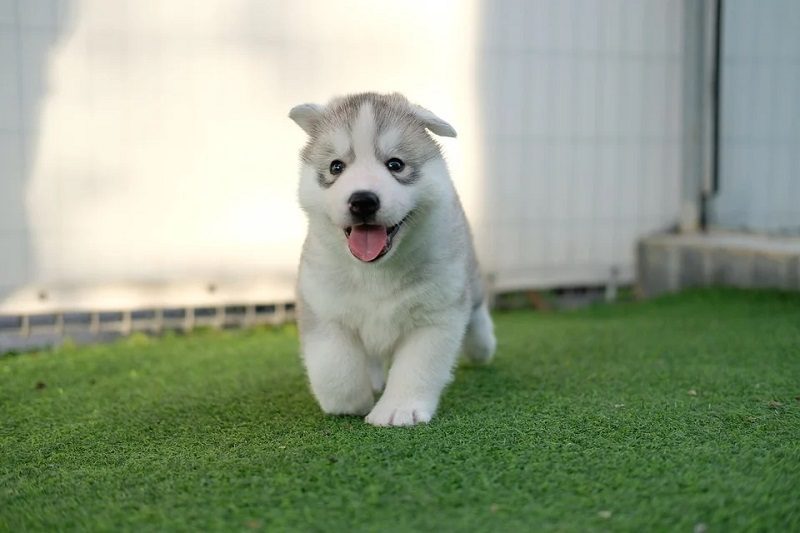
Siberian Huskies are fantastic dogs, they are excellent with kids, and they can make great family pets. However, owning a Siberian Husky can be somewhat of a challenge. So, before jumping in, you owe it to yourself and to the dog that you are thinking about bringing into your family to properly assess whether you can give a Husky the life they deserve.
To help you make this assessment, we recommend asking yourself the following questions.
Will a Siberian Husky suit my lifestyle?
To be a good owner, you will need to be able to train and socialize your dog, as well as supply it with daily attention and love, a safe and secure place to live, and an outlet for its almost endless energy.
Siberian Huskies don’t do well in households with other animals or those in which their owners work long hours or are away all day for other reasons. These dogs need a great deal of companionship, plenty of space in a secure yard, and somebody who is prepared to give them daily exercise. These are not the sort of dog that will get by on a brisk walk around the block each day. You need to be up for long daily walks and runs, and by daily, we mean every single day, whether it’s raining, sunny, windy, or snowing, and you’ll need to be able to keep it up for at least the next 12 years.
What’s the price of Siberian Husky puppies?
Owning a Husky is not cheap. For starters, they can be quite expensive dogs to purchase, and you should expect to pay anywhere from $500 to over $1,000 for a Siberian Husky puppy from a responsible breeder. You’ll also need to be able to afford routine veterinary care, regular flea and worming medication, and plenty of high-quality dog food.
Can I afford the costs of owning a Siberian Husky?
Over the course of your dog’s life, these expenses will add up to a substantial amount, and don’t’ forget to take into account any boarding costs that you may have from time to time, the price of any pet insurance that you might want to take out, and the expense of emergency care in the unfortunate instance that your dog is injured or becomes unwell.
Does everybody in my family want a dog?
This is a particularly important question and one that many people don’t sufficiently consider. Bringing a Siberian Husky into your family will have a significant impact on everybody in your household. You need to consider not just your current situation but also how your life and the lives of everybody in the house may change over the next 12-14 years.
Remember that Huskies are excitable dogs that could inadvertently knock over and injure a child or older person, which is something you may want to consider if you are planning a family or there is a chance that your elderly relatives may need to move in with you in the coming years.
Another important and often overlooked consideration is whether anybody in the house suffers from allergies or health conditions. Siberian Huskies are a double-coated dog that will shed frequently and “blow” their thick inner coat at least once a year, so you should anticipate that you will have dog dander in your house at all times. This is something that will be quite bothersome for anybody with dog allergies and could also impact on those suffering from respiratory illnesses such as asthma.
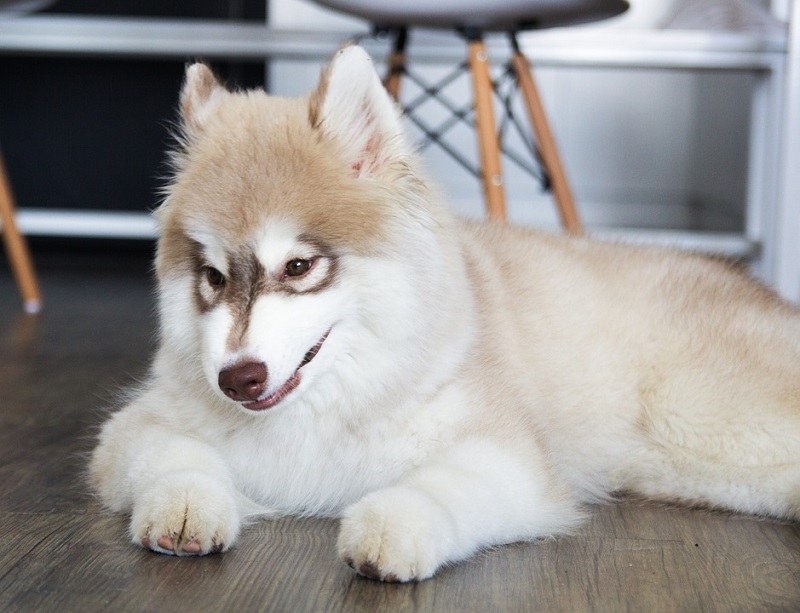
Do I want a puppy or an older dog?
Puppies are cute, and Siberian Husky puppies are outright gorgeous, but having one in your house presents a few challenges that not everybody wants. For starters, puppies are like naughty little kids: They will get into everything you own, they will create a mess everywhere, and they’ll require constant guidance and a great deal of patience. They’ll also need house training, socialization, and plenty of obedience training.
If you’re not up for all this, you may want to consider getting an adult rescue dog. It is an unfortunate fact that many Siberian Huskies end up in shelters through no fault of their own. Often bought as puppies by well-intending owners who didn’t understand the challenges of owning them, these dogs often just need a good home with an owner who is prepared to put in the time with them.
A word of caution, though: many rescue dogs will have behavioral problems. Some of these may be easy to address with training, but others can make a Siberian Husky dangerous. As such, it is important to meet any potential rescue dog in person, and if possible, consider fostering them for a while to ensure that they’re a good fit for you and your family.
- Related Read: Should I Adopt A Puppy or an Adult Dog?
 3 Little-Known Facts About Siberian Huskies
3 Little-Known Facts About Siberian Huskies
1. The Siberian Husky is now virtually extinct in its native land.
In the early 1900s, the Russian monarchy was overthrown and replaced by the communist regime that was to become the USSR. As part of this process, the communists vowed to rid the nation of all the “elite” aspects of Russian life and move to the communist model of collectivization.
By the 1930s, the forces of communism had reached the Arctic north, where thanks to the popularity of their dogs, many of the top breeders of the Chukchi dogs (now known as the Siberian Husky) had assumed leadership positions and a degree of wealth.
Considered by the communists to be a hindrance to change, most of these community leaders were imprisoned or killed and their possessions taken over by the communist state. As a result, within a few years, their dogs all but disappeared from Siberia says The Crazy Pet Guy.
2. The Siberian Husky is no longer the sledding champion they once were.
In much the same way that the Chukchi people selectively bred the original Siberian Huskies to be the best dogs for pulling light loads over long distances, modern dog sled racers have continued to develop dogs to meet the needs of their sport.
Speed was never an essential ingredient in a successful dog team for the Chukchi. Therefore, it was not a trait for which the Siberian Husky was bred. It is, however, an important part of winning sled races, and as such, new breeds have been developed that can outpace the Siberian Husky. The new champion dog as far as the sled racing community is concerned is the Alaskan Husky, a dog bred from the Siberian Husky and Alaskan Malamute and then crossed with several different racing breeds.
3. The “Game of Thrones” television series had a bad effect on the Siberian Husky.
After seven seasons of watching dire wolves, the mascots of the House of Stark on Game of Thrones, fans of the “Game of Thrones” TV show have developed an emotional bond to these mythical wolf-like dogs. As a result, many fans have been drawn to the Siberian Husky because of their wolf-like features and have started purchasing them as pets.
While their increase in popularity would normally be a positive thing, unfortunately, many of these fans have given little thought to what is involved in raising and owning a Siberian Husky. As a result, over the past few years, the number of Huskies that have been turning up at rescue shelters with “Game of Thrones” inspired names has increased significantly.
The trend has also encouraged less-than-ethical breeding practices, and several puppy mills are known to have been set up specifically to cater to “Game of Thrones” fans.

Temperament & Intelligence of the Siberian Husky
The Siberian Husky has a friendly and affectionate temperament and with the right training, can be an outstanding pet and companion.
Unlike some working breeds, Siberian Huskies don’t form particularly strong bonds with just one owner. Rather, they are usually agreeable with people of all ages and show affection to all members of their family.
Siberian Huskies are not good watchdogs, and unless a potential thief is scared off by their looks alone, they are unlikely to be of any assistance in guarding their owner’s property. However, they do have a strong predatory instinct. They are swift, cunning, and patient hunters, which means they can’t be trusted around small animals such as cats, rabbits, or guinea pigs.
- Related Read: Dog Breeds Similar to Huskies
Are These Dogs Good for Families?
The Siberian Husky is a generally a good-natured and well-mannered dog. Still, their success or otherwise with a family will largely depend on how well they have been trained and socialized. They typically have no problem with children, and although wary of strangers, they are not likely to become aggressive.
The one exception to this is with an overly timid or anxious dog. When mistreated or not socialized, Siberian Huskies can develop an anxiety problem. With that, they may become snappy and bite without provocation. While it is much more likely to be an issue in rescue dogs than a dog you have raised yourself from a puppy, it is something to watch out for, as anxiety biters can be quite dangerous.
Does This Breed Get Along With Other Pets?
The simple answer to this question is, no. Siberian Huskies don’t usually get along with other pets.
Due to their highly developed prey drive, they are not at all suitable to be kept with cats, rabbits, or any other small animal, as they will see your pet as prey and something to chase, and it’s not likely to end well for your other pet when your Husky catches up with them.
About the only exception to the rule is to get another medium-sized to large active dog. Huskies have worked closely with other dogs for centuries and typically have no major problems with them. However, if you do get another dog, it is always best to get them at the same time that you buy your Husky puppy because this way, they can grow up together, and you’ll unlikely to have any issues with them getting along.
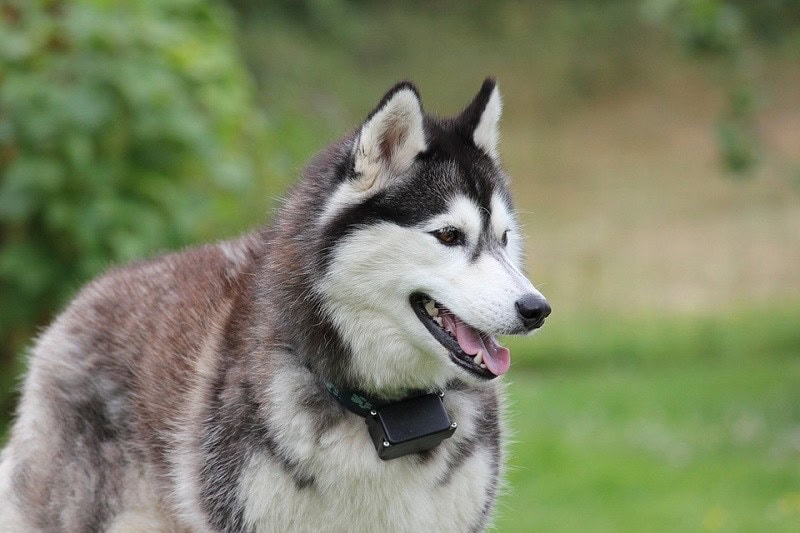
 Things to Know When Owning a Siberian Husky
Things to Know When Owning a Siberian Husky
Food and Diet Requirements
What you choose to feed your Siberian Husky will have a direct impact on their overall health and longevity. It is therefore vitally important that you choose a dog food that will provide a complete and nutritionally balanced diet for your dog.
Fortunately, in the United States and most other developed countries, commercially made dog foods are readily available and are manufactured to exacting standards that are the result of many years of research into canine nutrition.
It is important that you research the various dog foods that are available and select one that specifically states that it provides a complete and balanced diet for dogs. There are many different brands and types of food on the market. It’s best to select a premium quality dry dog food that has been specifically formulated for active medium-sized dogs.
- Not all dog food is the same. Try: Best Food for Husky Puppies
Exercise
To say that Siberian Huskies are a highly active breed that needs daily exercise is almost an understatement. Perhaps the best way to consider this is to look at their history.
The Siberian Husky was developed by the Chukchi people in Siberia to pull sleds over long distances, a task they did famously well for hundreds of years. But in practical terms, what this means for owners of Siberian Huskies is that for centuries, this breed has been refined to run. Hence, it should come as no surprise that running is ingrained into a Siberian Husky’s subconscious; it is simply an innate part of who they are.
As a result, if a Siberian Husky doesn’t get the daily exercise that they need, they will do everything in their power to take themselves out for a run. This includes climbing fences, worming their way through the smallest of gaps to escape, and even digging their way out. Then once out, they are going to do what they do best: run.
Every year, many Huskies end up in shelters because owners can’t stop them escaping from their seemingly escape-proof yard and running away. Sometimes, unfortunately, escaping and running results in Siberian Huskies being hit by cars or chasing and killing small animals in a neighbor’s yard. At other times, it results in people losing their dogs, as while they are running free, Siberian Huskies often give little thought to where they are or how they’re going to get back home.
There is only one solution to this problem, and that is exercise and a great deal of it.
Know your dog and their needs
Even with Siberian Huskies, every dog will be different and will have individual exercise needs. Some may be fine with one long walk each day and an hour or two of playtime with their owner in their yard. In contrast, others will want you to take them on a 5-mile run each morning and then back it up another 5-mile walk in the evening.
If you raise your dog from a puppy, you will have the greatest input into determining what your dog expects each day by setting their routine. This doesn’t mean that you can simply set a routine that doesn’t involve going out at all, but rather you can tailor it somewhat to ensure that you can keep up with your dog. For example, if you’re not a runner and can never take your dog for a 5-mile run, it is unlikely that your dog will have the fitness to run that far non-stop either. So, instead, you might get your dog used to exercising at a brisk walking pace.
It is also important to remember that your dog’s exercise requirements will change over time. Although a Siberian Husky is never likely to be a couch potato, as they advance toward old age, their desire to run and need for exercise will wane somewhat.
The myth of a big yard
Having a large and secure yard in which your Siberian Husky can run about and play is essential. Still, it is no substitute for a long walk or run.
Your Husky will tear around the yard, wearing tracks into your expensive lawn and spend hours digging moon-sized craters all over the place, but neither of these things will sufficiently meet your dog’s daily need for exercise. Nor will it provide the same mental stimulation that they can get from going out into the wider world, where there are all new sights, sounds, and smells to exercise their mind.
Your Siberian Husky needs both these things to stay happy and healthy, and the key is to get your dog out of their yard every day to exercise their body and their mind. Besides, you will likely meet other people and dogs on your way, and this is a great way to reinforce their socialization training.
Always put safety first
Siberian Huskies should never be walked off-leash in public areas. With their tendency to run and their high prey drive, walking them off-leash would be flirting with danger. It would only take a glance at a squirrel, cat, or another small animal for them to take off after it, giving no thought as to whether they are about to run out into traffic or somebody else’s yard.
Regardless of how well trained your dog is or how they act around other animals you know, it is simply not worth the risk. Unfortunately, this means that unless they are completely secure and closed in, running free in public off-leash areas should also be avoided with a Siberian Husky. This is not to say, however, that you can’t invest in a long leash and allow your dog more freedom to move about and play with other dogs, only that you need to do so in a way that ensures that they can’t run off.
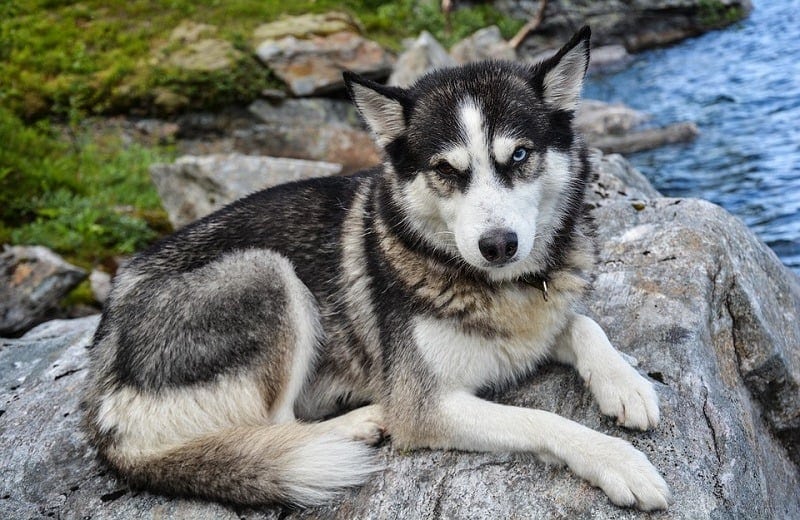
Training
Training and socializing your dog are an especially important part of owning a Siberian Husky. Yet, due to the independent nature, it can also be quite a challenge, and this is where your patience and perseverance as a responsible dog owner will need to come in.
The first thing you need to know is that basic dog training is not about teaching your dog to do tricks. It’s about making sure your dog can live happily and harmoniously as a member of your family and about teaching them how to behave to ensure that they don’t become a problem for you and your local community.
The main goal of your dog’s basic training is to encourage desired behaviors and suppress any unwanted ones. It is important, for example, that your dog learns to walk on a leash without lunging at other dogs, or growling at people riding past on a bike, and that they learn not to jump up on visitors.
Socialization
It is essential that you start your Siberian Husky on its path to good manners early in life, and the best way to do that is by taking them to puppy socialization classes, also often known as Puppy School. These classes are often community-based but are also sometimes put on by a local vet clinic or dog training school. Depending upon where you go, there may be a small fee involved to attend, but you are just as likely to find one that runs free of charge for residents in your local area.
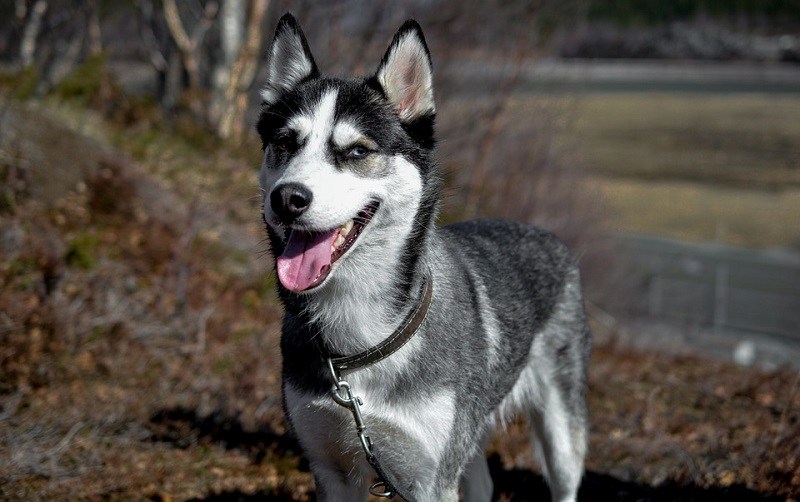
While you and your dog will get an introduction to a few basic training and discipline techniques at these classes, the goal is not to teach dog obedience, but rather to show you basic handling and housetraining methods and allow your dog to mix with other people and dogs in an unfamiliar environment.
This early introduction to interacting with other dogs is vitally important for a young Siberian Husky, as is learning how to act when around strange people. Above all, attending Puppy School will instill a sense of self-confidence in your dog and create a positive attitude toward training.
Obedience Training
Unfortunately, far too many people stop their dog training after just a few sessions and after that, rely on what is commonly known as “the school of hope.” Of course, this typically amounts to nothing more than hoping that your puppy will eventually grow out of all their bad habits and start listening to you of their own accord. The chances of having any real success are virtually nonexistent, but unfortunately, that doesn’t stop people from leaving their dog’s training up to luck.
A far better method is to have a structured training program that starts with the basics, then reinforces and encourages good behavior and builds on your dog’s success. By far, the easiest way to achieve this is to employ the services of a professional dog trainer. This can be either in private or group training classes, though both you and your dog will probably get more out of group training sessions than having a trainer come to you for a private lesson.
Group training is preferred because you get the structure of an organized class and program and your dog will benefit from socializing with the other dogs in the class. There may even be time for a bit of free play in a secure yard after the class is over.
Consistency is key
One or two formal group training sessions each week for a couple of months is usually enough to give a Siberian Husky the basic obedience training that they need. However, the real key to success is continually reinforcing what is learned in class at home.
There is no point in having the best-behaved dog in class if they think that what they’ve learned doesn’t apply at home. The only way to get them to behave in the way that you want them to is by practicing and reinforcing the learning at home.
Outside the structured class environment, it is not unusual for a dog to be less interested in training. After all, it is a different environment, and at home, there are familiar distractions. Therefore, it is necessary to find a way to keep your dog interested, particularly when conducting reinforcement training. This may be by rewarding them with treats or a quick game of fetch or even a good pat. Regardless of the method chosen, don’t push your dog too hard at the start. Regular, consistent reinforcement will yield far better results than a small number of long sessions.
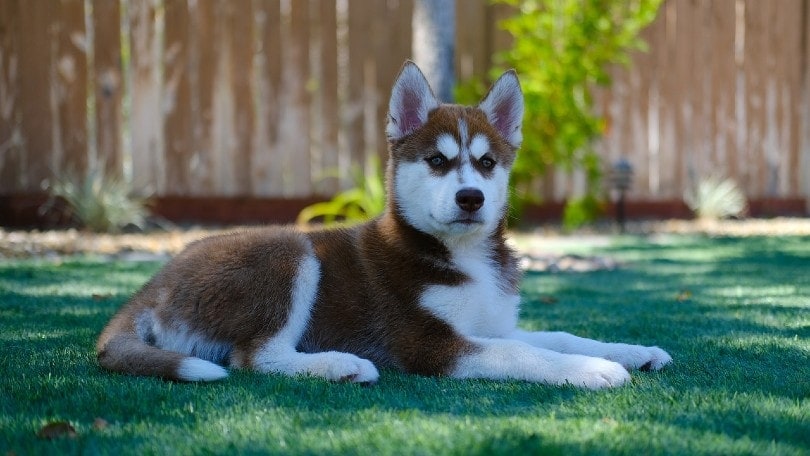
Grooming ✂️
Siberian Huskies have thick double coats that serve to keep them warm and dry in even the harshest of weather conditions. This means they have a thick woolly undercoat, through which a harsher outer coat grows.
Huskies will shed continually throughout the year and will “blow” their whole undercoat once each year if they are male and twice a year if they are female. Shedding will also be worse if you live in a warm, humid environment, as your dog won’t need the full warmth of their undercoat.
Throughout most of the year, a Husky will need only need a quick weekly brush to keep their coat looking its best. However, when it comes time for them to blow their undercoat, brushing with a pin brush will be required daily for about 6 weeks. Alternatively, you could engage the services of a professional dog groomer who can de-molt your Husky in one sitting.
- Keep that coat under control – Best Brushes for Huskies
Health and Conditions
Looking after your pet’s health is the most important aspect of owning a Siberian Husky or any dog, for that matter.
Our pets rely on us for every aspect of their health, from ensuring that they eat well to getting the right amount of exercise and mental stimulation and even making sure that they are appropriately socialized and receive the necessary training to live harmoniously with us and our families. But there is another vitally important aspect of keeping your Husky healthy that is often overlooked: ensuring that your dog gets a regular check-up with their vet.
Why are regular check-ups important?
Veterinary visits can be expensive, so many people only take their dogs to the vet when they are injured or unwell, but this can be a costly mistake — both financially and for the health of your dog.
Regular visits to the vet are essential for both the prevention and early detection of diseases and other health issues. Remember, dogs age much quicker than humans, and even with an otherwise healthy animal, it is important to keep on top of issues that if left undetected, could affect their wellbeing. Ideally, you want your Siberian Husky’s vet to get to know your dog’s individual issues and traits, which will make detection much easier if a problem starts to develop.
Vaccinations
Puppies will typically receive their first vaccinations before they are 2 months old, which is another reason that it is important to purchase your Siberian Husky pup from a reputable breeder.
These first vaccinations are usually for distemper, adenovirus/hepatitis, and parvovirus and will be carried out when your puppy is about 6-8 weeks old, with follow-up shots needed between 10-12 weeks, as per a schedule advised by your vet. At 14-16 weeks, your puppy will need further follow-up shots and their first rabies vaccination. Booster rabies shots will be required every 1-3 years, depending upon the state in which you live.
It is important to keep a record of your Siberian Husky’s vaccinations and ensure that you keep them up to date as advised by your vet. You can find both further information about dog vaccinations at the PetMD website.
Parasites
Parasites such as worms, fleas, ticks, and lice can be extremely problematic with dogs, particularly outdoor-loving breeds like the Siberian Husky.
Preventative medications for most of the common parasites that affect dogs are readily available, and a schedule for future doses is something that you should discuss with your puppy’s breeder and your vet during your first visit. It is easy to get complacent about these medications, particularly in winter, when fleas and ticks are less likely to be a problem. However, your Husky’s regular preventer medication is required year-round to ensure that they remain free of parasites.
You can find further information on common parasites and their control at the Companion Animal Parasite Control’s Pets and Parasites website or from your dog’s vet.
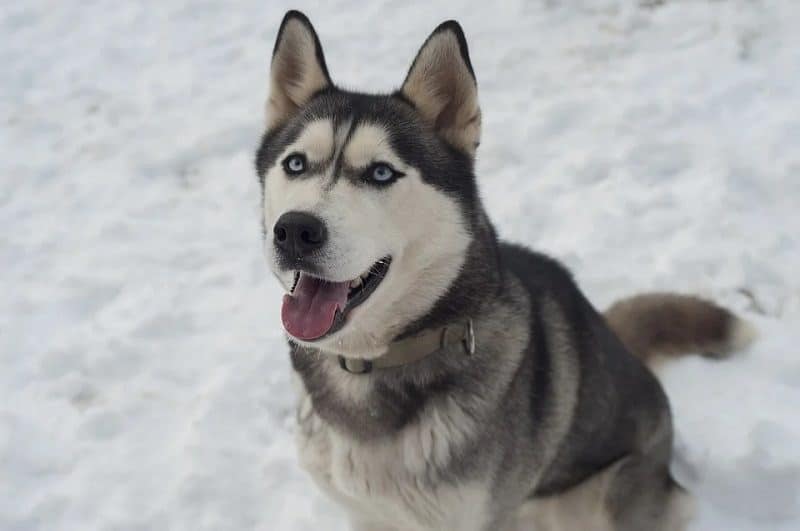
Common Health Problems
Siberian Huskies are an extremely hardy breed and are capable of living in the harshest environments on the plant. Still, even the healthiest of dogs will have a few illnesses at some point in their lives. Most will be no more serious for your dog than a common cold is to humans, but as your Siberian Husky will be unable to tell you that they do not feel well, it’s important to understand common symptoms that may indicate that your dog is unwell.
According to WebMD’s Fetch website, there are 10 signs to look out for that may indicate your dog is unwell. These include:
- Vomiting
- Diarrhea
- Lack of appetite
- Decreased activity
- Urinating more or less
- Coughing
- Hair loss
- Itchy skin
- Stiffness/lameness
- Difficulty rising
Breed Abnormalities
While no breed is totally free of genetic defects or abnormalities, few have a health record as good as Siberian Huskies. As one of the oldest dog breeds, Siberian Huskies have a relative lack of genetic issues. Nonetheless, the breed’s national club, the Siberian Husky Club of America (SHCA), keeps a watchful eye out for potential problems.
Since 1965, the SHCA has maintained a committee to monitor for the start of any genetic problems in the breed. To date, only two major defects have been discovered in this manner: canine hip dysplasia and three types of inheritable eye disease
On each occasion, the SHCA board of directors developed and distributed guidelines to help breeders decrease the spread.
- Hereditary or juvenile cataracts
- Hip dysplasia
- Corneal dystrophy
- Progressive retinal atrophy
 Male vs Female
Male vs Female
With Siberian Huskies, the main difference between the two sexes comes down to their size. Male Siberian Huskies are typically between 21 and 23.5 inches tall and weigh between 45 and 60 pounds. Females, on the other hand, will usually stand between 20 and 22 inches tall and weigh between 35 and 50 pounds.
As medium-sized dogs, there is not a huge difference between the size of the two sexes, but it is enough to be noticeable.
Should you wish to keep your dog whole for breeding purposes, there are also a few differences in temperament between male and female Huskies. Whole females will likely be more territorial when in heat than male dogs and may also be more affectionate. Whole males will have a much greater urge to roam than females, which, given this breed’s propensity to run great distances, can make life a little more challenging if your male Siberian Husky finds a way to escape from their yard.
Of course, many of these reproductive behaviors can be almost completely eliminated by spaying or neutering your dog, a simple and routine procedure that will also eliminate any chance of unwanted pregnancies.
One other difference between male and female Siberian Huskies is the rate at which they blow their undercoats. Males Huskies will usually only blow, or shed, their thick undercoat once a year, while females will blow their undercoat twice each year. As a result, female Siberian Huskies will require more grooming than males.
- Related Read: 15 Russian Dog Breeds: An Overview
 Final Thoughts
Final Thoughts
The Siberian Husky is a beautiful dog that can be a great family pet and companion. Still, they are not an easy dog to own, nor are they suitable for everybody.
We strongly encourage anybody who is looking at buying or rescuing one of these dogs to do their homework first and to spend as much time as possible with a breeder or another owner of these dogs to see firsthand whether a Siberian Husky is the right dog for them.
Featured Image Credit: albertlsy7101, Pixabay

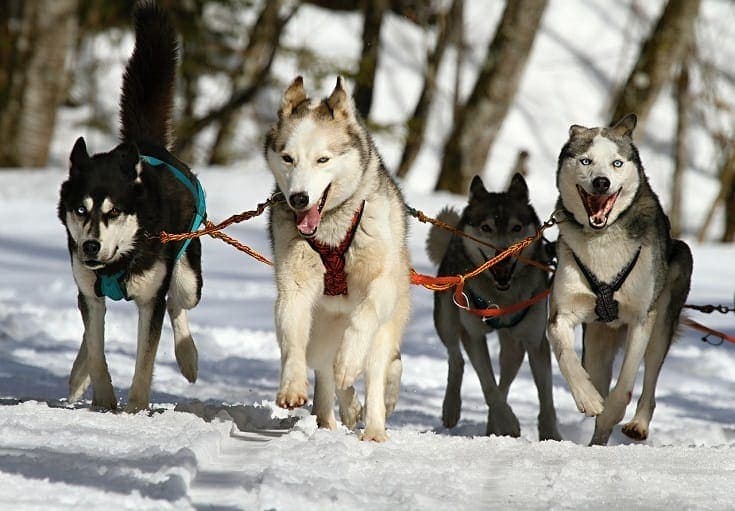
 Siberian Husky Puppies — Before You Buy…
Siberian Husky Puppies — Before You Buy… 3 Little-Known Facts About Siberian Huskies
3 Little-Known Facts About Siberian Huskies
 Things to Know When Owning a Siberian Husky
Things to Know When Owning a Siberian Husky Male vs Female
Male vs Female